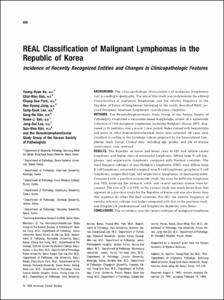REAL Classification of Malignant Lymphomas in the Republic of Korea
- Keimyung Author(s)
- Lee, Sang Sook
- Department
- Dept. of Pathology (병리학)
- Journal Title
- Cancer
- Issued Date
- 1998
- Volume
- 83
- Issue
- 4
- Abstract
- BACKGROUND: The clinicopathologic characteristics of malignant lymphomas vary according to geography. The aim of this study was to determine the clinical characteristics of malignant lymphomas and the relative frequency in the Republic of Korea of lymphomas belonging to the newly described REAL (revised European-American lymphoma) classification categories.
METHODS: The Hematolymphoreticular Study Group of the Korean Society of Pathologists conducted a consensus-based morphologic review of a nationwide collection of 1548 malignant lymphomas, including Hodgkin's disease (HD), diagnosed at 23 institutes over a recent 2-year period. Slides stained with hematoxylin and eosin or other immunohistochemical stains were reviewed. All cases were classified according to the histologic criteria proposed by the International Lymphoma Study Group. Clinical data, including age, gender, and site of disease involvement, were reviewed.
RESULTS: The Republic of Korea had lower rates of HD and follicle center lymphoma and higher rates of extranodal lymphoma, diffuse large B-cell lymphoma, and angiocentric lymphoma compared with Western countries. The most frequent subtypes of non-Hodgkin's lymphoma (NHL) were diffuse large B-cell lymphoma, extranodal marginal zone B-cell lymphoma, peripheral T-cell lymphoma, unspecified type, and angiocentric lymphoma, in decreasing order. Compared with a previous nationwide study, the rates for follicular lymphoma and NHL involving the stomach, orbit, and central nervous system were increased. The rate of T-cell NHL in the current study was much lower than that reported in a previous study for the Republic of Korea and was also lower than that reported for other Far East countries. For HD, the relative frequency of nodular sclerosis subtype was higher compared with that in the previous study, and lymphocyte predominance and lymphocyte depletion were lower.
CONCLUSIONS: The occurrence rates for various subtypes of malignant lymphoma in the Republic of Korea are distinct from those in Western countries and similar in many ways to those in other countries in the Far East. Compared with other Far East countries, the Republic of Korea has a higher rate of extranodal lymphoma, rare adult T-cell lymphoma, and a relatively low rate of T-cell lymphomas. It appears that over time there have been changes in the relative rates for follicular lymphoma, subtypes of Hodgkin's disease, and gastric and orbital lymphoma. The authors attribute these changes primarily to refined criteria for diagnosing new clinicopathologic entities.
- Keimyung Author(s)(Kor)
- 이상숙
- Publisher
- School of Medicine
- Citation
- Young-Hyeh Ko et al. (1998). REAL Classification of Malignant Lymphomas in the Republic of Korea. Cancer, 83(4), 806–812. doi: 10.1002/(SICI)1097-0142(19980815)83:4<806::AID-CNCR26>3.0.CO;2-V
- Type
- Article
- ISSN
- 0008-543X
- Appears in Collections:
- 1. School of Medicine (의과대학) > Dept. of Pathology (병리학)
- 파일 목록
-
-
Download
 oak-aaa-00731.pdf
기타 데이터 / 91.26 kB / Adobe PDF
oak-aaa-00731.pdf
기타 데이터 / 91.26 kB / Adobe PDF
-
Items in Repository are protected by copyright, with all rights reserved, unless otherwise indicated.